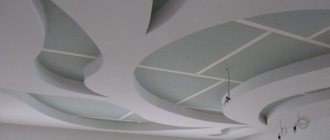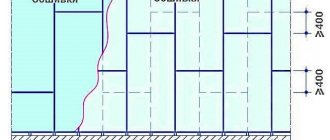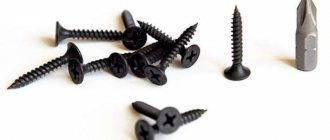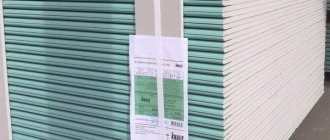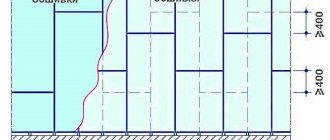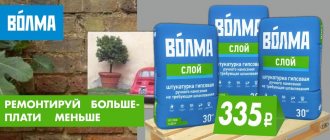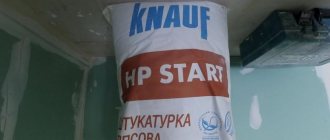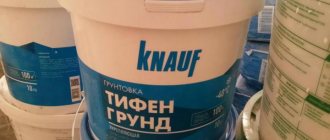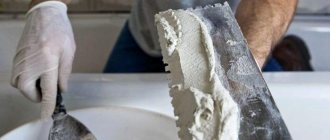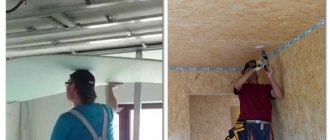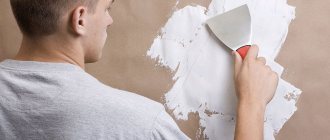Today, in repairs and construction, high-tech and modern materials are often used, which we have never heard of before or encountered during the course of work. Such inventions, of course, include gypsum tongue-and-groove slabs. They are chosen in many cases, including for redevelopment of apartments and houses instead of the usual brick or blocks. And brick, especially lately, is not considered seriously at all as a competitor. Why have GGP slabs gained such popularity among the population, whether it’s “Volma” or “Knauf” - it doesn’t matter?
Features of Knauf products
The sales leader is considered to be the German brand Knauf, which has over 10 enterprises producing building materials in Russia. Products of a foreign brand are characterized by strength, lightness, sanding, cutting and bending well.
The company produces various types of gypsum boards depending on the purpose:
- 9.5 mm are intended for covering the ceiling .
- For wall treatment - 12.5 mm .
- To create uneven, curved structures - 6.5 mm .
Standard sheet dimensions are 2500*1200 mm , but there are other options. The length varies in the range of 1500-4000 mm , width - 600-1500 mm . Thickness can also vary from 6.5 to 24 mm . The weight of drywall varies between 12-35 kg .
The manufacturer offers several types of gypsum boards to choose from. The most popular is the standard version, used for covering the ceiling and walls. The cost of drywall varies depending on its main characteristics.
Advantages:
- Precise geometry for easy installation.
- Smooth, homogeneous surface with increased adhesive properties.
- The presence of reinforcing fibers in the composition, providing high strength of the material.
- No fragility.
- The optimal percentage of moisture absorption does not exceed 5%.
- Free from toxins.
- Formation of a comfortable indoor microclimate.
Minuses:
- Difficulty in processing due to the presence of reinforcing fibers in the composition, making it difficult to
- Creation of complex geometric shapes.
- Expensive price, exceeding analogues by an average 20-30%.
Drywall Volma: characteristics, selection and installation
Today, the building materials market offers plasterboard from several manufacturers, and one of the noteworthy ones is plasterboard sheet from. Questions often arise on construction forums about which drywall is better - Volma or Knauf, and to make the selection process easier for you, we will try to describe this finishing material in as much detail as possible.
Three-meter gypsum board from
Gyprock from
Material characteristics
Finishing plasterboard, produced by the Volma corporation (Volgograd), is practically no different in composition from all other brands of plasterboard:
Volma Corporation logo
- The basis of drywall is made of natural gypsum. Gypsum is first ground in special mills and then fired at a temperature of about 180-200 0 C.
- The top and bottom of the gypsum board is covered with multilayer protective cardboard. The side edges of the cardboard are folded, reliably protecting the edges of the board from chipping.
- Depending on the type of material, Volma gypsum board may contain additional components, such as starch, glass fiber, cellulose fiber, hydrophobic impregnations, antifungal compounds, etc.
According to the information provided by the manufacturer of the material on the corporate website, Volma products are intended for wall cladding, installation of suspended ceilings and interior partitions made of plasterboard, as well as for the manufacture of other interior elements.
Note! The installation instructions for gypsum boards "Volma" recommend the use of special profiles and fasteners from the same manufacturer. However, as practice shows, compliance with this recommendation is desirable, but not mandatory.
Nomenclature of gypsum board
Under the Volma brand, several varieties of gypsum boards for interior work are produced.
The most popular are:
- “Volma-list” is a standard drywall (GKL) with dimensions of 1200 x 2500 mm. The thickness of the plates is 9.5 and 12.5 mm. This plasterboard is used for covering walls and ceilings in rooms with normal temperature and humidity; the characteristics of the material comply with GOST requirements. The appearance of the gypsum board is shown in the photo.
- "Volma Moisture-resistant" - GKLV. Slab dimensions – 1200 x 2500 mm. Thickness 9.5 and 12.5 mm. This type of gypsum board is used for leveling walls and ceilings in rooms with high humidity, such as bathrooms, toilets, kitchens, etc.
- Experts also recommend using moisture-resistant gypsum board when covering unheated premises - country houses, outbuildings, etc.
- "Volma Three-meter" - gypsum board with dimensions 1200 x 3000 mm. This type of gypsum board is produced upon special order and is used for cladding large areas. The use of large-sized panels can significantly save time on leveling the walls of the room.
As you can see, the range is quite extensive, although it is inferior to the variety of gypsum plaster brands from the world's leading manufacturers.
As for quality, here is a clear answer to the question asked at the beginning of our article, “Which drywall is better - Knauf or Volma?” pretty hard. The thing is that the bulk of Knauf drywall, so respected by our craftsmen, is produced at domestic enterprises.
And therefore, it would be unreasonable to talk about the superiority of one brand over another only on the basis of the place of manufacture.
Well, if you analyze the reviews of the majority of craftsmen who had the opportunity to compare both brands, then Volma is practically not inferior to KNAUF in quality. Taking into account the fact that the price of Volgograd products is somewhat lower, we can safely recommend this gypsum board for use.
Additional components
In addition to the plasterboard itself, the Volma brand also produces additional components designed to facilitate the installation of plasterboard and its subsequent finishing:
- Galvanized profile. Used for assembling frames for covering walls and gypsum board ceilings. Unfortunately, the product line of profiles is not very diverse, so a situation may arise in which you have to buy a starter or rack profile from another manufacturer.
- Glue for drywall. It is used for frameless installation of gypsum boards on walls and ensures high-quality adhesion to almost any surface.
- “Volma-shov” is a putty for sealing joints between gypsum board sheets. It is characterized by high plasticity, low shrinkage coefficient, and does not contain toxic substances.
Sealing mixture
Note! Manufacturers of putty recommend using it together with sickle tape or construction paper tape (also presented in the catalog on the company’s website).
- Finishing putty. Used for final leveling of surfaces covered with plasterboard sheets. Can be used both for painting and wallpapering. It has high hiding power and good adhesion properties.
In addition to all of the above, when installing Volma drywall, you can use specially designed fasteners from the same company.
Characteristics of plasterboard "Magma"
"Magma" is a domestic manufacturer of gypsum boards, producing products since 2008 . Experts love this material for its ease of processing. It can be easily cut and sanded, and self-tapping screws easily fit into it. In terms of performance, Magma plasterboard is not inferior to the best international analogues. It bends perfectly and is suitable for creating arches, columns, multi-level partitions, ceilings, decorative elements and figured structures.
Advantages:
- Compliance with GOST standards.
- Precise geometry.
- Minimum consumption of additional materials.
- No manufacturing defects.
- Uniform gypsum composition in the center of the sheet.
- Reliable retention of the fastener.
- Heat retention.
- Low price.
GKL "Magma" is an ideal option for leveling ceilings and walls, allowing you to save money on office or household repairs.
Which drywall is better?
Which drywall is better can be determined from the comparison table, taking into account the requirements for its installation and budget.
- If we look formally, the winner is Knauf, as it offers high-strength wear-resistant material with a wide range of standard sizes, as well as an almost ideal surface.
- However, with a limited budget, it turns out that Volma is better, since its cost is on average up to 30% cheaper than Knauf, due to the use of domestic raw materials in production. Volma is also more attractive for cladding arches and forming suspended ceilings due to its simple processing and optimal flexibility.
Comparison of Magma and Knauf products
It is quite difficult to establish unambiguously whether “Knauf” or “Magma”, since in certain situations, due to installation features or operating conditions, some materials win and others lose. For this reason, experts recommend using several tips.
The main rule when choosing drywall is visual inspection of the sheet for defects ; it is also necessary to take into account the storage and transportation conditions of the material. Therefore, it is better to buy gypsum boards in large specialized stores. If the material is not damaged and meets the basic selection criteria, then the manufacturer does not play a special role.
Comparison table between Knauf and Volma drywall
In order to figure out which drywall is better, you can use the table comparing products from Knauf and Volma.
| Parameter | Knauf | Volma |
| Sheet sizes | Width 0.6 or 1.2 m, length from 2 to 4 m. Standard sheet size 2.5x1.2 m. | Standard sizes are 2.5x1.2 m or 3x1.2 m. |
| Drywall thickness | From 6.5 to 16 mm. | From 9.5 to 12.4 mm. |
| Material Density | Up to 30.6 kg/m3. | Up to 30.6 kg/m3. |
| Flammability class | G1 | G1 |
| Type of edge used | Semicircular thinned. | Rectangular thinned edge. |
| Main product lines |
|
|
| Presence of reinforcing fibers | Yes. | No. |
| Moisture absorption level | Up to 5%. | Up to 5%. |
| Presence of antifungal impregnation | Yes. | Yes. |
| Possibility of forming surfaces of complex shapes. | No. | Yes. |
Which material is better?
Knauf plasterboard should be chosen for finishing surfaces subject to external mechanical loads. If it is necessary to use a decorative layer without plastering or with a minimum volume of mortar, the choice is obvious in favor of Knauf products due to the absence of unevenness, high cardboard adhesion and the ability to choose any base color.
GKL "Magma" allows you to save on surface finishing due to its affordable cost . This is an ideal option for people on a limited budget who dream of making quality renovations. The cost of this drywall is up to 30% than Knauf products, due to the use of inexpensive raw materials in the development. For finishing arches, creating suspended ceilings and complex shapes, Magma is also more effective due to its simple processing, excellent flexibility and lack of fragility.
As for the soundproofing qualities, they are, according to experts, better compared to Knauf products.
Volma plasterboard - domestic high-quality material
Volma plasterboard has been produced in Russia since 1999 after the reconstruction and modernization of the Stalingrad gypsum plant. Due to the presence of our own gypsum mining enterprises, it was possible to establish inexpensive production of the material at modern facilities using unique technologies. In terms of cost and quality, Volma plasterboard is the best among all manufacturers present on the market.
The modern production base has made it possible to establish the production of specialized types of plasterboard and virtually completely cover the needs of the domestic market. In terms of its technical and operational characteristics, Volma gypsum boards are in no way inferior to their foreign analogues, thanks to which these products have become the most popular in the domestic market.
Main advantages
The advantages of Volma plasterboard sheets include the following:
- high accuracy of sheet geometry, which makes it possible to simplify installation work and obtain hermetically sealed joints;
- optimal ratio of strength and ductility of sheets, providing the ability to cover surfaces of complex shapes;
- ease of cutting drywall with high quality edges that are not subject to crumbling;
- the ability of the sheet to absorb the load and distribute it evenly along the entire surface due to the use of gypsum sintering technology at a temperature of +200°C;
- low price of material and excellent technical characteristics;
- almost ideal durable surface with excellent adhesion thanks to the use of multi-layer cardboard.
Disadvantages of gypsum board Volma
Drywall produced by Volma has the following disadvantages:
- lack of marking lines, which complicates the process of aligning sheets during installation;
- slight surface waviness due to the characteristics of the production technologies used.
conclusions
The comparison showed that it provides a wide selection of sizes and high strength of the material, and Magma products allow you to create complex surfaces when facing.
If you look at it on a large scale, the winner is German brand plasterboard , which offers high-strength, wear-resistant material with a wide selection of standard sizes and an almost ideal surface. But, in conditions of a limited budget, the products of a domestic brand turn out to be better.
Repair and constructionComment
Review and cost comparison
- Plasterboard sheet Knauf/Knauf 2500x1200x9.5 mm
260.00 rub.
Product code 32
Knauf plasterboard sheet is a rectangular element that consists of two layers of sp.....
- Plasterboard sheet Knauf/Knauf 2500x1200x12.5 mm
360.00 rub.
Product code 8
Knauf plasterboard sheet is a rectangular element that consists of two layers of sp.....
- Plasterboard sheet Knauf/Knauf moisture resistant 2500x1200x9.5 mm
360.00 rub.
Product code 9
Knauf moisture-resistant is a rectangular material that consists of two layers of special.....
- Plasterboard sheet Knauf/Knauf moisture resistant 2500x1200x12.5 mm
370.00 rub.
Product code 11
Knauf moisture-resistant is a rectangular material that consists of two layers of special.....
- Gypsum plasterboard sheet Knauf/Knauf fire-resistant 2500x1200x12.5 mm
420.00 rub.
Product code 21
Knauf fire-resistant - gypsum building boards with increased resistance of the gypsum core during air.....
GGP brand Volma
The manufacturer Volma produces two versions of the GGP:
- Hollow (lightweight) – weighing from 20 to 23 kg;
- Full-bodied (monolithic) – weighing from 27 to 33 kg.
GGP Volma
Retail outlets of this manufacturer offer moisture-resistant (hydrophobic) GGP products with a green marker. Boards with the addition of glass fiber are also produced to increase reinforcing properties.
The size of the Volma blocks is no different from KNAUF. The thickness is presented in only one version - 80 mm. Therefore, if the project plans to have a thick load-bearing partition on which a large load will be placed, then it is better to use German products.
The lightness of hollow slabs gives them advantages during transportation and lower load on the base. This allows the construction of double partitions for additional insulation. Due to the air voids in such slabs, they have greater heat and sound insulation. The downside is some loss of strength.
What is the difference between these materials
Despite all the similarities, there are differences that are important to consider. The whole point here is how exactly the drywall will be used, and what result you want to get in the end. Understanding this and the difference between these two options, it will be possible to choose the optimal material for certain jobs.
Here's what makes the materials different:
- Volma is more affordable.
- Volma is more environmentally friendly.
- Knauf cuts better and can take a rounded shape.
- Knauf has better acoustic properties.
- Knauf has good dielectric properties.
The surface of Knauf drywall is smooth and even . But Volm's is wavy . In addition, there are no marking lines. This makes Knauf a more convenient material to use. At least in general.
Hence the slight difference in technology . Volma slabs must first be marked. It's not difficult if you have experience. But otherwise it will take quite some time. Yes, Volma products are quite resistant to various bends, however, still not as much as Knauf.
The difference is that Knauf is suitable for a greater number of tasks. For example, due to greater flexibility. So if a person is looking for some more or less universal option, it’s worth paying attention to Knauf.
At the same time, Volma is more environmentally friendly and economical. And this is also important. But aesthetically the material is not as good as Knauf brand products. And of course, given all these differences, the question inevitably arises of what is better to buy.
